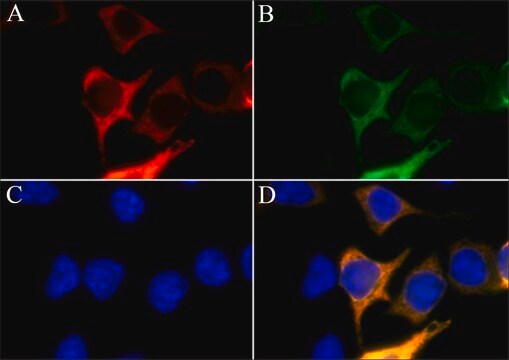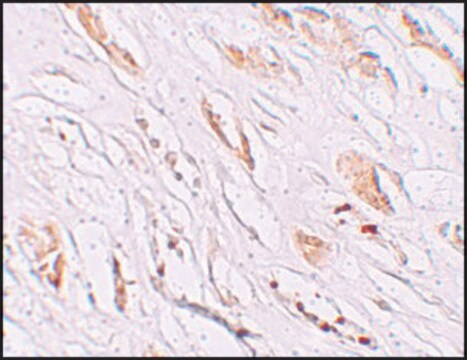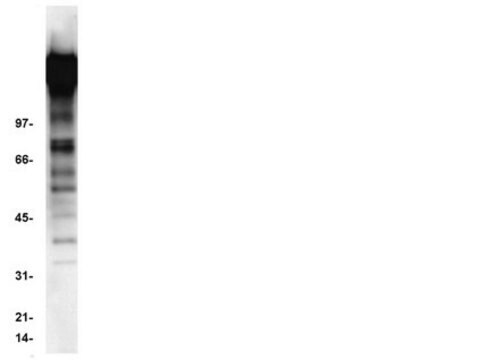推荐产品
共軛
FITC conjugate
品質等級
抗體表格
purified from hybridoma cell culture
抗體產品種類
primary antibodies
無性繁殖
7A9-3A3, monoclonal
形狀
buffered aqueous solution
儲存條件
protect from light
濃度
~1.0 mg/mL
技術
immunofluorescence: 1:200-1:400 using human HEK-293T cells over-expressing CAS9 protein
同型
IgG1
UniProt登錄號
運輸包裝
dry ice
儲存溫度
−20°C
目標翻譯後修改
unmodified
一般說明
CRISPR (Clustered Regularly Interspaced Short Palindromic Repeats) belongs to the type II CRISPR/CAS9 system. It is part of an adaptive immune system of the Streptococcus pyogenes SF370, protecting from pathogens′ target genes by cleaving the foreign DNA in a sequence-dependent manner.
The type II CRISPR/Cas system has been adapted to expression in eukaryotic cells. The Cas9 endonuclease can be engineered with a single gRNA (guide RNA), directing a DNA double-strand break (DSB) at a desired genomic location. As a result, the cell activates endogenous DNA repair processes, either non-homologous end joining (NHEJ) or homology-directed repair (HDR). In comparison to other genome-editing technologies such as designer zinc fingers (ZFs), transcription activator–like effectors (TALEs) and homing meganucleases, the CRISPR/CAS9 system is a scalable, affordable and easy to engineer. Therefore, the anti-CRISPR/CAS9-FITC conjugated antibody can be a useful tool for detecting CRISPR/CAS9 positively transfected cells, revealing DSB sites in their genome.
The type II CRISPR/Cas system has been adapted to expression in eukaryotic cells. The Cas9 endonuclease can be engineered with a single gRNA (guide RNA), directing a DNA double-strand break (DSB) at a desired genomic location. As a result, the cell activates endogenous DNA repair processes, either non-homologous end joining (NHEJ) or homology-directed repair (HDR). In comparison to other genome-editing technologies such as designer zinc fingers (ZFs), transcription activator–like effectors (TALEs) and homing meganucleases, the CRISPR/CAS9 system is a scalable, affordable and easy to engineer. Therefore, the anti-CRISPR/CAS9-FITC conjugated antibody can be a useful tool for detecting CRISPR/CAS9 positively transfected cells, revealing DSB sites in their genome.
免疫原
Recombinant protein within the N-terminal region of Streptococcus pyogene Cas9
應用
Monoclonal Anti-CRISPR/CAS9-FITC recognizes the CAS9 protein in CAS9 construct over-expression systems. The antibody may be used in various immunochemical techniques including Immunofluorescence. The antibody successfully recognizes mutant Cas9 variants, including nickase Cas9 and dead Cas9 (dCas9) and does not cross react with FnCas9 from Francisella novicida bacteria and Cpf1 proteins from Acidaminococcus sp. (strain BV3L6) and Lachnospiraceae bacterium ND2006.
外觀
Solution in 0.01M phosphate buffered saline pH 7.4 containing 1% bovine serum albumin and 15mM sodium azide.
儲存和穩定性
For continuous use, store at 2-8°C, protected from light for up to one month. For extended storage, freeze in working aliquots. Repeated freezing and thawing is not recommended. If slight turbidity occurs upon prolonged storage, clarify the solution by centrifugation before use. Working dilution samples should be discarded if not used within 12 hours.
其他說明
This product is for R&D use only, not for drug, household, or other uses.
In order to obtain best results in different techniques and preparations we recommend determining optimal working concentration by titration test.
In order to obtain best results in different techniques and preparations we recommend determining optimal working concentration by titration test.
未找到合适的产品?
试试我们的产品选型工具.
儲存類別代碼
10 - Combustible liquids
閃點(°F)
Not applicable
閃點(°C)
Not applicable
Patrick D Hsu et al.
Cell, 157(6), 1262-1278 (2014-06-07)
Recent advances in genome engineering technologies based on the CRISPR-associated RNA-guided endonuclease Cas9 are enabling the systematic interrogation of mammalian genome function. Analogous to the search function in modern word processors, Cas9 can be guided to specific locations within complex
Luisa Bortesi et al.
Biotechnology advances, 33(1), 41-52 (2014-12-24)
Targeted genome editing using artificial nucleases has the potential to accelerate basic research as well as plant breeding by providing the means to modify genomes rapidly in a precise and predictable manner. Here we describe the clustered regularly interspaced short
Luciano A Marraffini et al.
Nature, 463(7280), 568-571 (2010-01-15)
All immune systems must distinguish self from non-self to repel invaders without inducing autoimmunity. Clustered, regularly interspaced, short palindromic repeat (CRISPR) loci protect bacteria and archaea from invasion by phage and plasmid DNA through a genetic interference pathway. CRISPR loci
Elitza Deltcheva et al.
Nature, 471(7340), 602-607 (2011-04-02)
CRISPR/Cas systems constitute a widespread class of immunity systems that protect bacteria and archaea against phages and plasmids, and commonly use repeat/spacer-derived short crRNAs to silence foreign nucleic acids in a sequence-specific manner. Although the maturation of crRNAs represents a
Martin Jinek et al.
eLife, 2, e00471-e00471 (2013-02-07)
Type II CRISPR immune systems in bacteria use a dual RNA-guided DNA endonuclease, Cas9, to cleave foreign DNA at specific sites. We show here that Cas9 assembles with hybrid guide RNAs in human cells and can induce the formation of
我们的科学家团队拥有各种研究领域经验,包括生命科学、材料科学、化学合成、色谱、分析及许多其他领域.
联系技术服务部门








